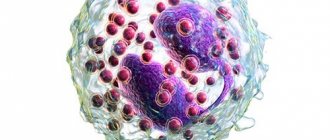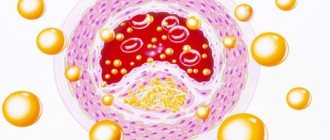Action of insulin
Insulin belongs to the category of polypeptide hormones, which are very important for the entire “organic universe” of man. What functions should he perform?
- It delivers amino acids to working cells. The hormone helps “open” the cell so that it allows glucose, a source of energy, to pass through.
- Participates in the process of building muscle tissue.
- Thanks to the hormone, potassium and amino acids are also delivered to the cells.
Fluctuations in the level of this polypeptide hormone can be accompanied by headache, spontaneous pain in the gastrointestinal tract, drowsiness and constipation. If the pancreas malfunctions, the normal production of insulin is disrupted.
When the numbers are below normal
First of all, poor pancreatic function is accompanied by an increase in blood sugar and is a prediabetic condition. What does low hormone levels indicate?
- Type 1 diabetes mellitus, in which little insulin is produced.
- A sedentary lifestyle, when the activity of muscles and tissues is reduced. Excessive eating of sweets - cakes, beer, candy.
- Regular loading of the pancreas with sugar and flour.
- Emotional and nervous stress.
- Period of infectious disease.
This reduced level of the hormone in the blood is associated with diabetes mellitus. But not always.
Norm
A low or high level of insulin in the blood is an alarm; you need to understand the reasons in time and take the necessary measures to maintain your health for many years.
The normal presence of the hormone in the blood is from 5.5 to 10 µU/ml. This is the average. On an empty stomach, its level is from 3 to 27 µU/ml. However, in women during pregnancy, the normal hormonal level is slightly higher than 6–27 µU/ml. This figure is also increased in older people.
You need to know: insulin levels are measured only on an empty stomach. After eating, its indicator always increases. Such a blood test, when a person has eaten in the morning, will not be correct. Post-meal insulin levels increase during adolescence. In childhood, there is no such dependence on hormone production.
Among doctors it is also recognized that a level of 11.5 µU/ml is already an indicator of a prediabetic state. That is, acquired diabetes mellitus develops.
Medical standard indicators
People with obvious prediabetic symptoms are referred for mandatory blood donation for insulin. An insulin test helps determine glucose levels and will indicate what type of diabetes needs to be diagnosed. Normal indicators:
- In a person without impaired organ function and normal sensitivity of glucose receptors, the normal limits are 3 – 26 µU per milliliter.
- In a child, with normal gland function - 3 - 19 µU per milliliter (in children compared to the adult norm - reduced).
- The period in children 12–16 years old is problematic for determining diabetes mellitus. For teenagers, the norm shifts. The child’s concentration changes in accordance with the increase in sex hormones, increased growth, and normal values often increase. Fixed indicator 2.7 - 10.4 µU, can be increased by 1 U/kg.
- The insulin rate for pregnant women should be taken slightly higher - 6 - 28 µU per milliliter.
- Elderly people have the following normal limits - 6 - 35 µU per milliliter.
The level of insulin in the blood of women changes from time to time and the indicator becomes higher when taking hormonal drugs. It decreases slightly during menstruation, since at this time the production of female hormones decreases.
Increased insulin in the blood
What happens to a person’s health when insulin is elevated? Blood sugar may only be normal temporarily in such a situation. Eating only carbohydrates leads to the need for the pancreas to keep insulin at a constantly high level. But over time, tissues become resistant to the hormone, and the gland depletes its resources. Insulin levels begin to drop.
Glucose still passes into fat layers; glycogen (unused energy) is stored in the liver. Blood sugar levels do not rise above normal levels immediately for a week or two. This process happens slowly. An increased level of the hormone insulin is just as unfavorable as a decreased one. Over time, a person faces the following diseases:
- cardiac ischemia;
- Alzheimer's disease;
- polycystic ovary syndrome in women;
- erectile dysfunction in men;
- hypertension (high blood pressure).
If elevated insulin is detected in the blood, what does this mean? This means that blood clots do not dissolve, blood pressure increases, the elasticity of blood vessels is impaired, and sodium is retained in the kidneys. That is, the health situation is getting worse all the time. According to rough calculations, the risk of myocardial infarction increases in such people by almost 2 times.
What is insulin
Substances produced by different cells of the pancreatic islets of Langerhans
Insulin is a hormonal substance of polypeptide nature. It is synthesized by β-cells of the pancreas, located in the thickness of the islets of Langerhans.
The main regulator of its production is blood sugar level. The higher the glucose concentration, the more intense the production of insulin hormone.
Despite the fact that the synthesis of the hormones insulin, glucagon and somatostatin occurs in neighboring cells, they are antagonists. Insulin antagonist substances include adrenal hormones - adrenaline, norepinephrine and dopamine.
Functions of the insulin hormone
The main purpose of the insulin hormone is to regulate carbohydrate metabolism. It is with its help that the energy source - glucose, located in the blood plasma, penetrates the cells of muscle fibers and adipose tissue.
The insulin molecule is a combination of 16 amino acids and 51 amino acid residues
In addition, the insulin hormone performs the following functions in the body, which, depending on the effects, are divided into 3 categories:
- Anti-catabolic:
- reduction of protein hydrolysis degradation,
- limiting excessive blood saturation with fatty acids.
- Metabolic:
- replenishment of glycogen reserves in the liver and skeletal muscle fiber cells by accelerating its polymerization from glucose in the blood,
- activation of the main enzymes that provide oxygen-free oxidation of glucose molecules and other carbohydrates,
- preventing the formation of glycogen in the liver from proteins and fats,
- stimulating the synthesis of hormones and enzymes of the gastrointestinal tract - gastrin, inhibitory gastric polypeptide, secretin, cholecystokinin.
- Anabolic:
- transportation of magnesium, potassium and phosphorus compounds into cells,
- increased absorption of amino acids, especially valine and leucine,
- enhancing protein biosynthesis, promoting rapid DNA reduplication (doubling before division),
- acceleration of the process of synthesis of triglycerides from glucose.
On a note. Insulin, together with growth hormone and anabolic steroids, belongs to the so-called anabolic hormones. They received this name because with their help the body increases the number and volume of muscle fibers. Therefore, the insulin hormone is recognized as sports doping and its use is prohibited for athletes in most sports.
Signs of increased insulin
It is better to detect insulin resistance as early as possible. While the body has not undergone significant pathological processes. To tell whether insulin in the blood is elevated or not, the doctor just needs to interview the person and find out whether the following problems bother him:
- chronic fatigue;
- difficulty concentrating;
- high blood pressure;
- weight increases;
- oily skin;
- dandruff,
- seborrhea.
If several of these symptoms are detected, you should immediately take a blood glucose test. And if from time to time the patient is bothered by attacks of hypoglycemia (a sharp drop in sugar), then a special diet is prescribed. The sugar level is then maintained mainly with the help of a glucose solution.
Insulin standards for adults and children
The hormone norm in a child (up to 12 years) differs from the adult norm - 20 µU/l. The lowest concentration in children is 3 µU/l.
In adults and adolescents over 12 years of age, the usual rate is 25 µU/l.
The amount of insulin is determined by a blood test taken from a finger prick on an empty stomach. There is also a text on glucose tolerance. In the morning, on an empty stomach, the patient is given a glass of water with a concentrated glucose solution. After some time, blood is taken and the analysis is determined after 60-90-120 minutes.
The level of the hormone can be determined by analyzing blood glucose using a home device - a glucometer. Depending on the glucose levels, insulin levels can be predicted. At 5.5 glucose - low or inactive. With a sugar indicator of 3.3 - high.
Losing body weight or lowering blood sugar is much more difficult and time-consuming to prevent. It is necessary to measure glucose regularly and also follow a preventive diet from time to time.
Causes of increased insulin. Insulinoma
It is important to know why insulin in the blood is increased. The reasons may vary. For example:
- prolonged hunger;
- heavy physical activity;
- pregnancy;
- taking certain medications;
- the diet contains too much food rich in glucose;
- poor liver function.
However, sometimes the cause is prolonged malnutrition and bringing the nervous system to complete exhaustion. Then you need long rest and good nutrition so that the hormone level returns to normal.
This anomaly is also caused by a tumor in the pancreas, which is called insulinoma. In cancer, insulin levels are always elevated. Insulinoma is also accompanied by other, more significant painful symptoms.
- Muscle weakness.
- Shiver.
- Visual impairment.
- Speech impairment.
- Strong headache.
- Cramps.
- Hunger and cold sweat.
Symptoms appear mainly in the early morning hours. Pancreatic cancer has no cure. The tumor can only be cut out and care must be taken to ensure that no secondary tumors arise in the brain or liver.
Characteristics of the hormone
The hormone insulin is produced by the islets of Langerhans (this is the definition given by scientists to the beta cells of the pancreas). The main task of insulin is to ensure that the amount of glucose in the blood is at a normal level for the body's functioning.
The hormone supplies glucose and other nutrients to all cells of the body, providing the tissues with the necessary amount of useful elements. If the islets of Langerhans begin to produce insulin below normal. the cells do not receive enough food, which is definitely detrimental to them: they begin to experience hunger and die, causing disruptions in the functioning of the body.
Another task of insulin is to regulate the metabolism of carbohydrates, fats and proteins, during which proteins are converted into muscle mass, while preventing muscle destruction. Also, insulin, through complex reactions, transforms excess glucose that can harm the body into glycogen.
The hormone deposits it mainly in the liver and muscles, creating a kind of “depot” (the weight of glycogen in the liver of an adult can reach 120 g). As soon as the body begins to feel a sugar deficiency, the glycogen that is deposited in the liver is broken down under the influence of enzymes, converted into glucose and released into the blood.
How to lower insulin levels?
But sometimes it happens that increased glucose is detected in the analysis, while blood insulin is quite consistent with normal levels. This analysis indicates the imminent onset of diabetes. A sedentary lifestyle leads to weight gain and metabolic syndrome. Endocrinologists call it a combination of prediabetic factors.
The body's failure to accept insulin is called insulin resistance. This is the first step towards metabolic syndrome. It is this mechanism that is triggered when too much sweet food is taken, and the body gets used to high levels of insulin. Then, despite the fact that the pancreas produces more polypeptide hormone, glucose is not absorbed by the body as it should. This leads to obesity. But sometimes this is due to aversion to fructose for hereditary reasons.
To prevent the process of “blocking” insulin, you need to help the body. Glucose must enter the muscles, the metabolism is activated, and the weight returns to normal. At the same time, the level of sex hormones is normalized. That is, you need to play sports and switch to healthy foods that suit your body type and lifestyle.
What does high insulin mean?
Insulin levels are affected by glucose concentrations in the major blood vessels. Normal levels are considered to be 3-20 µU/ml of blood (read more about what the normal level of insulin in the blood should be). An increase in this level can indicate both possible diseases and poor nutrition or recent stress.
In any case, exceeding the established level cannot be ignored. It is imperative to understand the reasons for the increase and methods of normalization.
Low insulin. Diabetes
Low insulin causes blood sugar to gradually rise. Cells cannot process glucose supplied with food. This situation is very dangerous. An increase in sugar levels is easy to notice. Symptoms that accompany glucose deficiency include:
- rapid breathing;
- blurred vision;
- loss of appetite;
- Sometimes vomiting and stomach pain bother me.
A very low level of such an important hormone is characterized by the following factors:
- I feel very hungry.
- Unreasonable anxiety worries.
- I'm thirsty.
- The temperature rises and sweat occurs.
Impaired insulin production ultimately leads to type 1 diabetes.
This type of diabetes develops in children and young people, often after suffering certain diseases. In this case, it is imperative to constantly monitor your glucose levels using a glucometer.
Insulin antibody test (Insulin AT)
The onset of type 1 diabetes mellitus usually occurs during childhood and adolescence.
This type of venous blood study is a marker of autoimmune damage to insulin-producing β-cells of the pancreas. It is prescribed to children who have a hereditary risk of developing type 1 diabetes.
With this study it is also possible:
- final differentiation of diagnoses of diabetes mellitus type 1 or 2,
- determination of predisposition to type 1 diabetes mellitus,
- clarifying the causes of hypoglycemia in people who do not suffer from diabetes,
- assessment of resistance and clarification of allergies to exogenous insulin,
- determination of the level of aninsulin antibodies during treatment with insulins of animal origin.
Antibodies to insulin are normal - 0.0-0.4 U/ml. In cases where this norm is exceeded, it is recommended to take an additional test for IgG antibodies.
Attention. An increase in antibody levels is normal in 1% of healthy people.
Diabetic neuropathy. Consequence of diabetes
Since insulin increases blood glucose levels, the functioning of the nervous system is disrupted over time. After 10–15 years of consistently high blood sugar, diabetic neuropathy begins. It is divided into several types: autonomous, peripheral and focal. Most often, diabetics are accompanied by signs of peripheral neuropathy. They are:
- decreased sensitivity or numbness of the limbs;
- lack of coordination;
- loss of balance;
- tingling, numbness and pain in the extremities (usually in the feet).
To prevent further development of neuropathy, you need to constantly get your blood tested and monitor your sugar levels. Quitting smoking and alcoholic beverages is mandatory.
Of course, the disease also occurs for other reasons - injuries, exposure to toxic substances, and other reasons. But almost always it is acquired diabetes, which slowly develops and gradually destroys the walls of blood vessels and nervous tissue, that is the cause of neuropathy.
Other consequences of diabetes are glaucoma and poor circulation. Blood circulation is reduced until ulcers form on the limbs, followed by amputation.
Rules for the patient when taking the test
In order for the blood test to be correct, without any distortions, you must follow the instructions on how to give insulin correctly:
- You should take insulin tests on an empty stomach, early in the morning.
- The day before taking insulin, avoid any physical activity.
- 12 hours before taking blood for testing, you should not eat foods high in sugar or carbohydrates—follow a diet. 8 hours before the procedure, do not take food or tea at all. Before the procedure, unsweetened mineral water is allowed.
- 2 days before you go to donate blood, you must adhere to a lean diet (exclude fatty foods).
- On the eve of the test, refrain from alcoholic beverages.
- Do not smoke for the remaining 2–3 hours before the procedure.
- The results of the study are almost independent of sex hormonal changes, so girls can donate blood for analysis even during menstruation.
In order to check the amount of production and function of the pancreas, venous blood is taken on an empty stomach. A few days before this test, it is recommended to avoid taking medications that increase blood sugar (glucocorticosteroids, contraceptives, cardio-beta blockers).
More accurate data on the normal utilization of glucose and the state of gland cells can be obtained by testing for insulin with a load. Blood is taken twice, the first time the level of the hormone insulin in the blood on an empty stomach is determined. Then 2 hours after taking the sweet solution (glucose test).
Diabetes treatment
Based on blood sugar tests, the doctor will prescribe the necessary treatment. In diabetes, which is caused by insufficient pancreatic secretion (type 1), you have to inject insulin 2 times a day. The doctor also prescribes a diet devoid of sucrose, which must be followed steadily throughout life.
Well, type 2 diabetes is most often a consequence of stress and an incorrect, sedentary lifestyle, which results in increased insulin in the blood. This type is called non-insulin-dependent diabetes and is treated with certain medications. It is advisable to find any sport you like and give moderate physical activity to your muscles. However, insulin levels also need to be constantly checked and consultations with your attending endocrinologist.
Dangers of severely low insulin levels. Diabetes
Diabetes mellitus is an insulin-dependent disease. It develops when insulin levels in the blood are low or there is an excess of inactive insulin. Therefore, high blood sugar leads to serious consequences.
Undigested sugar remains in the blood and can then be collected in the urine in the kidneys and penetrate through the bloodstream into the intercellular space unchanged. This leads to frequent urogenital infections, skin irritations and necrosis. Accompanied by all the following external symptoms:
- Deteriorated tissue trophism - decreased vision, neuropathy, impaired consciousness.
- A constant feeling of hunger is a lack of energy for the muscles when there are “storehouses” of sugar in the blood.
- Hypertension, headaches.
- Constant dry mouth, thirst.
- Decreased sensitivity of the limbs, tingling, pain.
- Joint disease.
The consequences of diabetes mellitus can be very serious - loss of vision, mental disorders, ulcers and gangrene of the legs.
In some cases, there is low insulin with normal sugar levels - this means insufficiency of the pancreas. If you have such symptoms, you should consult a doctor - an endocrinologist. Elevated insulin with normal sugar also indicates dysfunction of the endocrine system.
Proper nutrition for diabetics
The basis of diabetes treatment is diet. It depends on what the insulin level is. If insulin in the blood is elevated, you need to adhere to the following recommendations.
- Dairy products are healthy, but low-fat.
- Whole grains.
- Lean fish.
- Boiled eggs, no more than 3 pcs. for 7 days.
- Meat should be avoided, especially pork that is too fatty.
You must eat at strictly designated hours. Then the body will produce all the necessary digestive enzymes in time.
It is also important that the portions are small, but you need to eat 5 or even 6 times a day.
We know that insulin increases blood sugar, so for those who suffer from insulin-dependent diabetes, the diet is stricter. In such a diet, all calories must be strictly calculated so that there is enough insulin to process each molecule of sucrose into energy.
Therapy and normalization of insulin
Before starting therapy, you need to find the cause of increased insulin in the blood. After this, the doctor prescribes treatment aimed at eliminating the root cause and lowering the hormone. Increased insulin with elevated sugar levels contributes to dehydration and can be fatal.
Medicines
It is prohibited to take medications on your own to stabilize the pancreas.
This threatens the emergence of additional complications. Treatment for elevated blood insulin in adults includes taking medications that reduce appetite, blood pressure, and a decrease in hormone levels.
Folk remedies
It is impossible to fight high insulin levels in the blood exclusively using traditional methods; you can only stabilize it.
For this they use:
- juices of beets, carrots, sauerkraut, potatoes,
- buckwheat with kefir,
- bay leaf decoction.
Elevated insulin levels can be stabilized if you use all folk remedies together with medications and exercise therapy.
Diet
You can stabilize your pancreas if you follow your doctor’s advice regarding food. If you eat healthy foods, elevated insulin in the blood can be lowered or the negative consequences of the pathology can be reduced.
The diet includes an abundance of low-fat dairy products, cereals, lean meat, eggs, fresh or boiled vegetables, natural juices, as well as fruits, with a small amount of sugar and vitamin C.
If insulin is elevated, it is recommended to consume:
- cherries, apples,
- citrus,
- kiwi,
- currant.
In type 2 diabetes, the diet is not made for a short period, the patient follows it throughout his life. If the hormone is elevated, adhere to the following dietary rules:
- multiple meals in small portions,
- exclude alcohol,
- replace sugar with sweeteners,
- reduce salt intake,
- eliminate the consumption of canned food, fast food,
- controlled carbohydrate intake, it is important to divide them evenly throughout the day.
By following a diet, you can get rid of extra pounds.
Exercise therapy
When insulin levels are high, it is useful to engage in physical therapy. Exercises allow you to maintain your health at a satisfactory level or improve your well-being. If insulin levels are high, the doctor should recommend a specific group of exercises. But before starting to implement the recommendations, the patient is given an ECG.
While performing the exercises, monitor your heart rate, measure your blood pressure, and check your insulin levels in the blood. If your readings increase, you should consult a doctor.
Physical therapy has a positive effect on the body, including:
- the relationship between cells and hormones increases,
- improves blood circulation, heart function,
- the risk of complications is reduced,
- prevention of heart attack and stroke.
You should not do exercises on a skinny or full stomach. Before class, you need to eat a sandwich or several. Reduce the number of diabetes pills or the dose of the hormone.
The lesson is immediately carried out under the supervision of medical personnel. This is done so that, if necessary, it is possible to adjust the duration and types of exercises.
Life without bad habits is the best prevention
In fact, a disease like diabetes has almost no cure. In rare cases, an improvement in the patient's condition can be observed. In the event that he is constantly under the control of doctors.
But most likely, even with constant sugar control, the disease will progress and result either in a cancerous tumor, or in severe obesity, shortness of breath and a heart attack.
It is best to go for a walk more often, protect your nervous system from unnecessary stress through physical activity and a joyful attitude towards life. A moderate diet, without excess fat, without fast foods, will prolong your life and save you from many diseases. Not only from impaired insulin levels.
How is insulin produced in the body?
The organ responsible for producing insulin is the pancreas. It is located in the peritoneum, namely behind the stomach. The gland consists of three parts: the head, the body (the main part of the organ) and the tail. Experts point out that:
- the gland contains cells whose main function is the production of insulin;
- a cluster of such cells is called pancreatic islets, which are located in the tail of the organ;
- their second definition is the islets of Langerhans (they are named after the pathologist from Germany who identified them);
- cells ensure the production of hormones responsible for the regulation of metabolic processes (fat, protein and carbohydrate).
The hormonal component is secreted by beta cells exactly when it is needed. This reaction occurs when the glucose ratio in the blood increases. If a significant amount of carbohydrates enters the human body with food, then beta cells will be depleted under the influence of constant stress. Most often, this condition develops in people in old age, when hormone deficiency develops and the likelihood of developing diabetes mellitus increases.
What analysis allows you to determine insulin levels: the essence of the method
Venous blood serum is required for work
To perform an insulin test, the patient's venous blood serum is required. The study must be carried out on an empty stomach, or at the time of established hypoglycemia. The blood taken into a test tube is centrifuged, separating the liquid part from the blood cells. After this, the serum is frozen to -200°C and placed in a special test system. The method used for diagnosis is called immunometric, thanks to which it is possible to determine exactly the number of units of insulin among all serum proteins. If necessary, the test can be repeated two hours after the first one, but it should also be done on an empty stomach.
If the presence of “immunoreactive” insulin is suspected, when the tissues are insensitive to the hormone, before drawing blood, insulin is injected into a vein in a volume of 0.1 U/kg body weight of the subject and a system with a glucose solution is prepared for intravenous delivery, or the patient is given a glucose solution to drink . Blood is taken from a vein every 30 minutes for two hours. Tracking the amount of blood glucose will help determine the body's sensitivity to the hormone: normally, the glucose level will almost halve within 20 minutes, and return to its previous values after one and a half to two hours. An inactive decrease in glucose will indicate low tissue sensitivity to the hormone.











